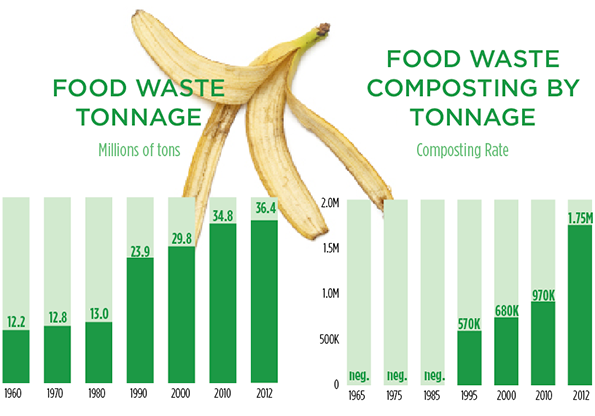Profiles in Garbage: Food Waste
Food waste includes food taken off retail shelves before or after the “eat-by date”, uneaten portions of meals, and trimmings from food preparation. It is the largest component of generated waste by weight. Food waste is the largest component of discarded waste by weight.
Estimates of the amount of food waste vary widely. EPA estimates that we each discard 0.64 pounds per day or 232 pounds per year. Other estimates are considerably higher. The Garbage Project of the University of Arizona estimated a per person rate of 1.3 pounds every day, or 474.5 pounds per year. The U.S. Department of Agriculture also has higher estimates of food waste than EPA.
Food processing facilities aggressively work to ensure their food wastes are recovered for composting or other applications not sent to disposal facilities. In addition, edible food can be diverted from retailers and other sources and sent to food banks to feed the hungry. EPA MSW data does not include either option. However, more than 15 million tons of food waste are diverted by food processing facilities and perhaps as much as 3 million tons are diverted as edible food.
Curbside collection of food waste composting is found in 198 American communities. Two-thirds of those programs are in three West Coast states. Large scale projects in Seattle and San Francisco are showing how to collect and compost food waste effectively, but cost, facility siting and vector control are concerns for new projects.
Anaerobic digestion facilities convert biomass, such as food waste, to energy under oxygen-free conditions. They produce a biogas, which can be turned into an energy source, and a digestate, which can be composted. The number of facilities that accept food waste is small but growing.
Over 60 million homes and 500,000 businesses have in-sink food disposers that divert food waste from landfills.
Food waste’s share of the solid waste stream increased by 5 percent from 1960 to 2012. During the same time, increased package and paper recycling caused food waste’s share of the disposal stream to increase by 43 percent.
Food Waste Solid Waste Facts (2012 EPA estimates)
Generated
36.43 million tons or 14.5% of MSW by weight.*
232 pounds per person.*
Food waste is 70% water, 30% solids.
Composted
1.74 million tons or a 4.8% recovery rate*
Organic and highly compostable.
Grocery store and food processing/manufacturing facility trimmings are a prime resource for composting facilities.
The Composting Process
Composting is the controlled decomposition of organic matter by microorganisms into a humus-like product by generating heat and energy to destroy weeds, plants and human pathogens.
Backyard compost piles that include food wastes must be tightly controlled to eliminate pests.
Composting Cost
Tipping fees usually charged for incoming food waste.
Incinerated or Landfilled
34.7 million tons or 21.1% of discarded MSW by weight.*
Usually the wettest component of MSW with moisture content of 70% and BTU value one-third of MSW.
Landfill Volume
21.4 million cubic yards or 5.3% of landfilled MSW (1997 data).
Food waste can decompose into methane in a landfill.
Density
Landfilled food waste weighs from 680 to 1500 pounds per cubic yard depending on moisture content.
Food scraps, solid and liquid fats weigh 412 pounds in a 55-gallon drum.
Source Reduction
Packaged foods create less food waste.
Portion control and smart shopping create less food waste.
In-sink kitchen disposal units divert food waste to wastewater treatment plants. In many cases, these facilities produce fertilizer or biosolid products.
End Market Specifications
Each facility has its own specifications. Non-organic materials such as metals and plastic must be kept out.
Sources
Municipal Solid Waste Generation, Recycling and Disposal in the United States, Facts and Figures for 2012, US EPA, Office of Solid Waste, 2014
National Recycling Coalition, Measurement Standards and Reporting Guidelines, Alexandria, VA, 1990

About the Author
You May Also Like




.png?width=300&auto=webp&quality=80&disable=upscale)